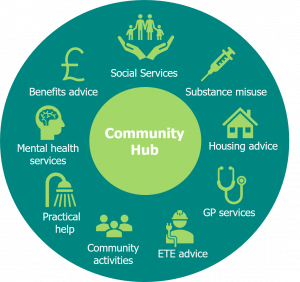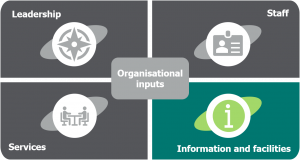Information and facilities
Key findings
- Policies and procedures should be regularly and proactively reviewed, improved and communicated to help staff assume responsibility and act quickly and effectively.
- Good practices and areas for development, improvement, creativity and innovation should be continually identified, with the organisation taking decisive steps to improve delivery.
- Clear communication on performance and effectiveness can help evaluative and reflective practice to become an integrated part of an organisation’s culture, with staff thinking critically about the evidence that underpins their actions.
- A range of approaches should be used to gain feedback from service users and other stakeholders, with a focus upon inclusivity. Attention needs to be given to engaging as many people as possible, including those whose voices are hard to reach and those at an earlier point in their desistance journeys.
- Well-designed safe and decent physical environments can support a rehabilitative culture and have a positive effect on staff morale and wellbeing.
Background
Delivering a quality service requires staff to be provided with timely and relevant information, with data on performance and effectiveness being used to drive improvement. Recent years have seen an increased focus on the importance of feedback from service users, including through ‘one-way’ consultations, the establishment of service user councils, or through greater involvement and co-production.
To clearly distinguish the input of service users and staff, the terms ‘lived’ and ‘learned’ experience are sometimes used:
- ‘Lived’ experience relates to the contribution provided by service users, and highlights that it is their own personal experiences, particularly of the criminal justice system, which enables them to offer a valuable perspective on probation services.
- ‘Learned’ experience relates to the contribution provided by staff, and emphasises that they have gained a detailed understanding of probation services through training and professional experience.
The delivery of a quality service also requires well-designed safe and decent physical environments. Recent years have seen the growth of community hubs, with a number of agencies working together to provide joined up services in one location.

Summary of the evidence
Access to the necessary information
The highest performing organisations ensure that its people have the necessary tools do their jobs well and deliver a quality service. The Information and Communication Technology (ICT) systems and associated protocols should support effective and service delivery and robust information exchange, with the ability to record and access key information whenever and wherever required.
Staff should have access to the necessary knowledge and information, facilitated through the organisation’s ICT systems, with clear policies and procedures in place to support them in making the decisions required in their specific roles. Policies and procedures should be regularly and proactively reviewed, improved and communicated to help staff assume responsibility and act quickly and effectively.
Using data and evidence to drive improvement
In strong organisations, leaders and managers have an in-depth understanding of strengths, weaknesses and capabilities. There are comprehensive arrangements in place to analyse, trend and benchmark performance, using reliable and timely information. A range of approaches should be used to gain feedback from service users and other stakeholders, with a focus upon inclusivity. Potential new ways of working should be explored through self-evaluation and through learning from others and applying findings from reviews, research and scrutiny. Evidence must be used to learn and adapt, with good practices and areas for development, improvement, creativity and innovation identified, and the organisation taking decisive steps to improve delivery.
Transparency is important, with the effectiveness of service delivery being evaluated, and successes and failures being openly communicated. There should be high levels of awareness regarding performance and effectiveness across the organisation, with relevant information translated across the organisation and communicated to staff in readily-accessible formats. Evaluative and reflective practice can then become an integrated part of an organisation’s culture, with staff thinking critically about the evidence that underpins their actions.
The views of service users
There has been growing attention in recent years to the potential value of service user involvement in the review and development of probation services. Service users’ lived experiences of the value of the service received should be an important part of organisational learning, with attention being given to general themes that indicate both strengths and ways in which the quality of the service could be improved. Attention needs to be given to engaging as many people as possible, including those whose voices are hard to reach and those at an earlier point in their desistance journeys.
Physical environments
There has been increasing research attention upon the importance of physical environment for probation delivery. The physical premises and offices should be accessible to all staff and service users and support a rehabilitative culture through encouraging positive and open interactions while meeting the requirements of safety, security, privacy and confidentiality. Well-designed safe and decent physical environments have also been found to have a positive effect on staff morale and wellbeing.
Delivery through community hubs has been seen as beneficial due to the multi-agency approach helping to address offending-related needs, develop and rebuild community and family relationships, and potentially support sustained behaviour change. The design of hub buildings – the openness, cleanliness and well-kept nature of the buildings – can help to convey a sense of respect, and can play a role in destigmatising the process of being on probation. Staff can also benefit from the co-location and multi-disciplinary nature of hubs, as they can seek immediate support from a range of other members of staff.

Example of a community hub
In our 2018/2019 probation inspections, we considered whether timely and relevant information was available and whether appropriate facilities were in place to support a high-quality, personalised and responsive approach for all service users. Across the 28 inspections, one provider received an ‘Outstanding’ rating, with ten receiving a ‘Good’ rating, and 17 rated as ‘Requires improvement’ (including six of the seven NPS divisions – the main driver being consistent failures of the facilities management contract, leading to probation staff working in buildings that were in disrepair).
Dominey, J. (2018). The Use of Community Hubs to Deliver Probation Supervision. Cambridge: University of Cambridge.
Phillips, J. (2014). ‘The architecture of a probation office: A reflection of policy and an impact on practice’, Probation Journal, 61(2), pp. 117–131.
Weaver, E., Moodie, K. and Lightowler, C. (2017). Coproduction in Community Justice: Exploring the Issues. Glasgow: University of Strathclyde.




